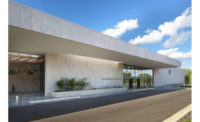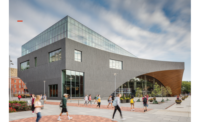Among the company’s new initiatives, it has partnered with New World Stoneworks to create an initiative that allows the company to quickly deliver natural stone that is selected, shaped and installed according to precise specifications. The system makes it possible to achieve exceptional results in any style of natural full-bed stonework with the benefit of faster project installation. The result is a structural piece with the unmistakable handcrafted aesthetic, delivered ready to install, with zero jobsite waste and costs the same or less per square foot as traditional full-bed stone products.
Also with an eye on the environment, Coldspring has teamed with green building pioneer Jason F. McLennan to launch Earth Measure — a new product line of “deep green” reclaimed stone.
Earth Measure is comprised entirely of remnant stone and is available in three customizable pattern series that uses nature as its inspiration. To produce Earth Measure, Coldspring takes stone that might otherwise be unsuitable as dimensional material, either ground up as aggregate or discarded as waste, and uses the company’s patented process to produce a manufactured stone. The stone line has a very low embodied energy, is manufactured with zero chemicals and can last for decades with little to no maintenance.
Recently, Stone World spoke with John Mattke, President of Coldspring, to gain some insight on the changes taking place at the company and the stone industry as a whole.
Q: Can you describe the changes that have been taking place at Coldspring?
Mattke: We are rebranding, and we are no longer Cold Spring Granite. We have a different logo, and the reasons are multi-faceted. First and foremost, we’re a lot more than granite. Fully a third of our business has nothing to do with granite at all. We are marketing other types of stone, and we have been in memorial bronze and decorative bronze business since the early ‘50s, and that business has grown. We are also aggressively promoting our diamond tooling business. We are aligned with the stone industry, but we are also producing products to cut, groove and grind concrete.
The forward-looking side of me wants to open other doors, and not to be limited to stone and certainly not just granite.
So far the market has received our name change very well. In the stone industry, we were known as “Cold Spring,” so people accepted it anyway. But in other industries, we went under different names that caused confusion. Becoming one Coldspring eliminates that issue and allows us to present ourselves in a more unified way.
We’ve entered into agreements where we are marketing new things, such as with New World Stoneworks. We’ve gone public with Earth Measure, the new product we offer with Jason McLennan [founder and author of the Living Building Challenge, the world’s most progressive and stringent green building program.] Earth Measure is aimed at creating specific designs to fully utilize stone in a sustainable fashion with sustainable packaging. We want to be the greenest stone company in the world, and we are partnering with the best in Jason McLennan, so we feel good about that.
Q: Is this product something that can be executed at quarry sites around the country?
Mattke: We’re working on developing capabilities to be very mobile, and we have a history with our own quarries. We have the capability to move into locations to extract and process stone. To me, the vision and the future is that we want to be able to produce and process anywhere at any time. Obviously, we want to fully utilize material from our own quarries, which are spread across the country, so I believe we are a natural for doing the groundbreaking of this approach in other locations as well. It is something new, and we feel like we can be the standard-bearer for a lot of innovation.
Q: Can you describe some of Coldspring’s goals for sustainability in the future?
Mattke: Beyond the obvious — improving energy and water consumption and getting rid of Red List chemicals — we participate in the Declare program coming from the International Living Futures Institute (ILFI). That’s a transparent material database or labeling system that requires manufacturers to disclose the ingredients in their product to ensure they are free of Red List chemicals and materials. Companies voluntarily participate in it, and our products carry the Declare label. It is all about transparency.
We also established our “2020 Initiative” several years ago, and the aim is that by 2020, we will be utilizing 100% of what we extract from the ground. That is not necessarily all in dimensional material, but by adding other types of operations we can more fully utilize our mineral extraction. Just about every type of material out there has some natural mineral component in it. That pushes us into a whole new realm of expanding and improving yields and diversifying business.
Certainly, though, improving the dimensional yield is a big part of that. From a sustainability standpoint, stone should be one of the most sustainable products in the world.
That has been one of the key drivers of our sustainability initiative. We’ve been environmental stewards since our beginning, 115 years ago. We’ve always appreciated the land and taken care of it. It is a sweet spot for us, but now that sustainability is such an issue, we have a platform to discuss what we are doing in a different way.
Q: Do today’s consumers care about sustainability and green practices?
Mattke: They do to some degree, but there’s a lot of apathy out there right now. The consumer is worried about more than that. With the economy sputtering, lower incomes and concerns about retirement, most families have more pressing issues on their minds. Over time, I think it will become a bigger and bigger issue.
For the newer generation, it is much more important. When you think out 10 or 15 years from now, when that generation is thinking about products in their home, it’s going to be a much bigger issue.
Q: How about commercial developers or project owners? How much do they care about sustainability?
Mattke: They care to the degree that they want to build a building with a shelf life of more than 25 years. There was a period of time when many developers weren’t worried about where a building would be 15 years down the road — it would have been sold off and become someone else’s problem — and that wasn’t healthy for the built environment. With the green building movement (USGBC LEED, ILFI LBC, AIA COTE, GSA) that is changing. The architectural community wants to change this, and there are some huge companies that are really behind this. There will be critical mass at some point. With continued change in regulations and building codes, the industry will continue to move in that direction.
There is a lot of confusion with USGBC, life cycle assessments and Environmental Product Declarations (EPDs) out there, and until it sorts itself out, it will move, but progress will be a little slower.
Q: Tell me about some of the new developments at Coldspring in terms of production (processing) as well as quarrying.
Mattke: We are adding some new technology — more with robotics, more technology and less manual labor. Our jobs are generally moving in the direction of being higher skilled, with a higher degree of computerized training.
In our processing, we are able to produce tighter tolerances than ever before. A good example of that was the Martin Luther King Memorial project. We produced serpentine benches on uneven ground, and the pieces matched up perfectly with almost no tolerance from joint to joint, greatly reducing installation labor and waste at the site and creating the effect of continuous flow with multiple pieces. To produce that way takes a certain amount of production technology, computerized modeling and a lot of drafters and programmers who have become true experts. This is the type of work we excel at, and we’re going to keep moving in that direction.
In the quarries, we are eliminating drilling and blasting as much as we can. We are trying to saw as much as possible. It minimizes noise and dust, it creates a better environment for the workers, and it ties into our yield initiative.
Q: What are some of the landmark projects we can expect to see Coldspring supplying in the future?
Mattke: Certainly, one of them is the World Trade Center in New York. There are a number of buildings and a lot of sitework, paving and curbing. We’ve also done vanities and interior flooring and lobby areas, and we expect that project and others that build out around it to continue for quite a number of years.
We always do a lot of government work, and we’re pursuing projects like that around the country. The market in general has been a little hesitant to move forward, though. The residential side is picking up, but the commercial side has been softer. I think it may begin to break free in the next six to 12 months, based on the amount we are quoting right now.
Q: In your experience, how has Coldspring evolved over the years?
Mattke: I joined the company 18 years ago, and we’ve evolved over time to be much more innovative, collaborative and nimble. We focus a lot more on providing solutions and services than just selling stone. We’ve always had good relationships in the markets we serve, but we’re doing a lot more to build on those relationships to execute better on a project. We are looking at things more holistically that way.
We are also a lot more open to doing things that will capitalize on some of our core strengths, even if it is in markets that are not traditional ones that we’ve been in — for example provide diamond tool technology outside of the stone industry.
The industry has evolved, too. Back in the ‘80s, every architect wanted to build with stone from the street to the top floor. Now they are using stone in different ways, and they are often using it a little more selectively. We’re certainly trying to change with that trend, and we will continue to work with the design community to help them understand stone in a variety of applications and feel comfortable using it.
Q: Speaking on the industry in general, where do you see us going?
Mattke: Stone is a natural material, and it has always been valued as a construction material. There is always going to be a place for stone. There are also a lot more substitute materials available in the marketplace today. From an industry standpoint, the message I would like to pass along is both optimistic and sobering. We can’t just do things the way our fathers and grandfathers did and expect to survive. We have a tendency to dig in our heels and hold on to the way we’ve always done things — almost in a nostalgic way — and it isn’t healthy for the industry going forward. We all compete for the natural stone projects out there, but our real competitors are concrete, steel, glass and brick. As an industry, we need to work in a more collaborative way to get that “rising tide that floats all boats.”
The problem is we are very fragmented. I get it, but I just can’t condone it. I understand the fear and anxiety of letting go of things and being more progressive, of taking risks and moving in a different direction, yet that is exactly what needs to happen. I hope we see resurgence — a building boom that is controllable and one that the industry can get excited about and maybe take some risks and move the dial forward.











